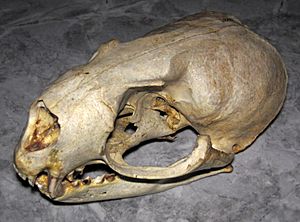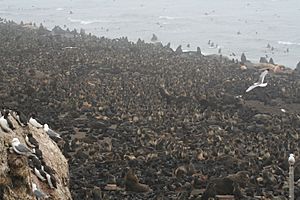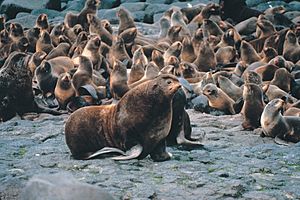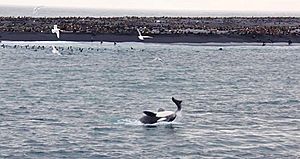Northern fur seal facts for kids
Quick facts for kids Northern fur seal |
|||
|---|---|---|---|
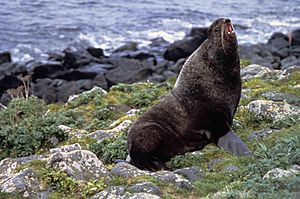 |
|||
| Conservation status | |||
| Scientific classification | |||
| Genus: |
Callorhinus
|
||
| Species: |
ursinus
|
||
 |
|||
|
|||
| Synonyms | |||
|
Phoca ursina Linnaeus, 1758 |
|||
The northern fur seal (Callorhinus ursinus) is a type of eared seal. You can find them in the northern Pacific Ocean, the Bering Sea, and the Sea of Okhotsk. It's the biggest kind of fur seal. It's also the only living species in its group, called Callorhinus.
Contents
About Northern Fur Seals
Northern fur seals have a thick, soft coat with dense underfur. This underfur is usually hidden by longer guard hairs. But you can see it a bit when the seals are wet.
Their front and back flippers are special. The front flippers don't have fur on top. The back flippers are the longest of any eared seal. This is because their toes have very long, bendy parts. They have small claws on some toes, but they are far back from the end.
Their ears are long and easy to see. Older seals might have bare tips on their ears. Their whiskers, called vibrissae, can be very long. They often reach past the ears. Adult seals have all white whiskers. Younger seals have a mix of white and black ones. Baby seals have all black whiskers. Their eyes are quite large, especially on females.
Males and Females
Male northern fur seals are much bigger than females. They are 30–40% longer and more than 4.5 times heavier.
Adult males have thick, wide necks. They also have a shaggy mane of coarse, longer hair. This mane covers their neck, chest, and upper back. Their heads look short because of their short snout and thick necks. Males also have a raised forehead.
Their canine teeth are much longer and wider in adult males than in females. This is true for all ages, but it's most noticeable in adults.
Adult females and younger seals are more moderately built. It's hard to tell males and females apart until they are about five years old. Their bodies, necks, and chests are all in proportion.
Females and younger seals have more varied colors. They can be dark silver-gray to charcoal on top. Their sides, chest, and neck are often cream to tan with rusty colors. They might also have cream or rust-colored spots on their snout and chin.
Adult males are usually medium gray to black, or reddish to dark brown all over. Their manes can have silver-gray or yellowish tints.
Baby seals are born blackish. They have oval buff-colored spots on their sides and chin. After three to four months, they shed their black fur. Then they become the same color as adult females.
Males can grow up to 2.1 meters (about 7 feet) long and weigh 270 kg (about 600 pounds). Females can be up to 1.5 meters (about 5 feet) long and weigh 50 kg (about 110 pounds) or more. Newborns weigh about 5.4–6 kg (12–13 pounds) and are 60–65 cm (24–26 inches) long.
Their teeth are sharp and cone-shaped. This helps them tear fish flesh. Like most dog-like animals, their upper canine teeth are very noticeable.
Northern fur seals are good at moving on land. Their back legs can rotate under their body. This lets them walk on all fours. When they swim, they use their front flippers to move. They have flexible joints in their spine. This helps them move easily in the water.
Where They Live
Northern fur seals live in the north Pacific Ocean. Their range goes from southern Japan to the southern tip of the Baja California peninsula. They also live in the Sea of Okhotsk and the Bering Sea.
About 1.1 million northern fur seals live in this area. Roughly half of them breed on the Pribilof Islands in the Bering Sea. Many others breed on the Commander Islands and Tyuleniy Island. Smaller groups breed on Bogoslof Island, San Miguel Island, and South Farallon Island off California. Old bones show that these animals used to breed in more places along the coast of North America.
In winter, northern fur seals move south. Seals from Russia often go into Japanese and Korean waters. Seals from Alaska move along the central and eastern Pacific. They can go as far south as British Columbia, Canada and Baja California.
Northern fur seals sometimes live in the same breeding areas, called rookeries, as Steller sea lions. The only other fur seal in the Northern Hemisphere is the Guadalupe fur seal. Its range slightly overlaps with the northern fur seal's in California.
What They Eat and Who Eats Them
Northern fur seals eat whatever food they can find. They mostly eat fish and squid that live in the open ocean. They eat fish like hake, herring, lantern fish, capelin, pollock, and mackerel. They usually hunt alone.
Sharks and killer whales are the main predators of northern fur seals. Sometimes, very young seals are eaten by Steller sea lions. Arctic foxes have also been seen eating live pups.
Many pups can die on the breeding grounds. This is because there are so many pups in one place. Also, mothers start looking for food when their pups are very young. So, dead pups are an important food source for scavengers. These include gulls and Arctic foxes.
Reproduction and Life Cycle
Seals arrive at their breeding grounds, called rookeries, in May. Older males (10 years and up) usually arrive first. They compete for the best spots to breed. They stay on the rookery and don't eat during the whole breeding season.
Females arrive a bit later. They give birth soon after they arrive.
Females stay with their pups for the first eight to ten days. Then, they start going on trips to find food. These trips can last up to a week. They continue these trips for about four months. Then, they suddenly stop feeding their pups, usually in October.
Most seals leave the rookery and spread out by the end of November. They usually travel south for the winter. Female seals tend to return to the same breeding site each year. Young males might go to other rookeries or find new resting spots.
Status and History
People are worried about the number of northern fur seals. Especially on the Pribilof Islands, the number of pups has dropped by about 50% since the 1970s. It keeps dropping by 6–7% each year. Because of this, they are listed as "vulnerable" in the U.S. This means they are at risk of becoming endangered.
Scientists are studying them more to find out why this is happening. Possible reasons include more predation by killer whales, competition with fishing, and climate change. But scientists don't all agree on the main cause yet. The IUCN (a group that tracks species) also lists them as "vulnerable" globally.
Fur Trade History
Native people in northeast Asia and Alaska have hunted northern fur seals for thousands of years. They used them for food.
When Europeans arrived in Kamchatka and Alaska in the 17th and 18th centuries, a big commercial fur trade began. This trade grew even faster in 1786. That's when Gavriil Pribylov found St. George Island, a major seal breeding ground. It's estimated that 2.5 million seals were killed between 1786 and 1867. This caused the number of fur seals to drop a lot.
The Russians first put limits on seal hunting on the Pribilof Islands in 1834. After the United States bought Alaska from Russia in 1867, the U.S. government allowed companies to hunt seals on the Pribilofs. From 1870 to 1909, hunting seals in the open ocean caused a huge decline. The Pribilof population, which used to be in the millions, dropped to only 216,000 animals by 1912.
Major hunting mostly stopped when the North Pacific Fur Seal Convention of 1911 was signed. Great Britain (for Canada), Japan, Russia, and the United States signed this agreement. This treaty was important because it was the first international agreement to protect wildlife. It stayed in effect until World War II. A new agreement was signed in 1957.
Today, people living on St. Paul Island are allowed to hunt a small number of seals for their own use. A very small hunt also happens in Russia.
See also
 In Spanish: Oso marino ártico para niños
In Spanish: Oso marino ártico para niños




